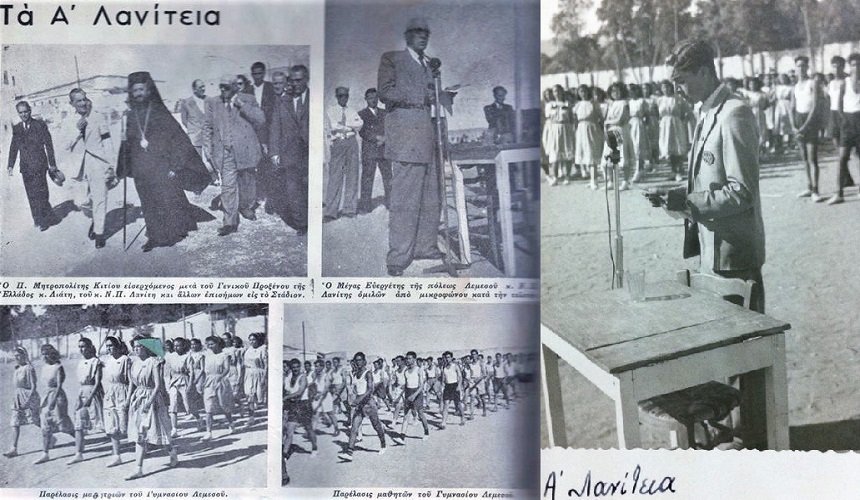
In January 1945, with an official letter on behalf of N. P. Lanitis, the authorities responsible for the Greek educational system in Limassol received a donation of £20.000 (an extremely large amount at the time) for the purpose of the foundation of suitable school in the city. At that exact time, the history of a school spreading in a piece of land of 120.000 sq. meters, which is still today a landmark for Limassol and a pride for the city and the rest of Cyprus, was just beginning.
Before the school took its place on the piece of land north to Archbishop Makarios Avenue, by the name Lanitio High School, there were several attempts for the institution of proper education in Limassol, during some really harsh times. Since 1819, upon the foundation of the Limassol Greek School (a precursor of the 1st City School, which is still operating, and the Greek High School, which evolved into Lanitio High School) the matter of the school’s housing was a main issue that troubled the initiators of this effort. This, the construction of Lanitio, a modern building, efficient and suitable for the educational purposes (as the donor N. P. Lanitis asked in a relevant letter), was crucial for the local society.
The Greek School (1819) was originally housed on the upper floor of a house with 3 rooms, located in the yard of Ayia Napa church. The School had to close due to the turbulent times during the Greek Revolution in 1821 against the Ottoman Rule. Just before the island was bought by the British, the school opened again and around 1900, the Greek High School was settle in a proper building, located in the area where the Municipal Parking Area is found now – right opposite the CUT – built with the assistance of the Greek Government.

The statue of N. P. Lanitis in the school's front yard (find out more about the family and life of N. P. Lanitis here).
Thanks to the donation by the trader Nikolaos P. Lanitis “…because of his natural love and affection towards the city of Limassol” (as the donation paper from back in 1945 mentions) and due to the fact that both him and his brother, Costas, were not fortunate enough to receive proper education, the new, modern and majestic school building opens its doors, at the same place where it is still operating until now. The Greek High School was then renamed Lanitio High School, to honor its benefactor, and his statue was placed in the school’s atrium.

Every year, a celebration dedicated to the benefactor N. P. Lanitis would take place, with athletic competitions and shows and traditional Greek and Cypriot dances.
Lanitio was one of the cores of the struggle during 1955 – 1959 against the British Rule. On December of 1955, the students have the leading role in a rebellion that takes place in the school’s areas, to demand their right to free education, and they occupy all open areas, from the yard to the roof top. The rebellion is suppressed and the school closes down and even deleted from the school buildings archive, in order to serve as a camp, for around 1 year. Several months later, the school opens once again, but the male students that graduated in 1956, were the first (and only) ones to receive a certificate from the Girls’ School. Now, the western entrance of the school hosts a monument dedicated to the Struggling Students.
Moments ffrom the life of the school community back in the 1960s and 1970s, with music events, trips and parades, as well as poetry lessons in the classroom.
In the area of Lanitio, the Girls’ High School was a building that followed right after the first one, which was later named Lanitio High School II, a small church for religious ceremonies held for the students, the stadium, the primary school, the theatre and the offices of the Schools’ Bureau of Limassol. Now, this area hosts the Lanitio High School, the 12th Lanitio Primary School and the Cyprus Institute. Since 2006 the Musical and Athletic High School were instiruted, too, and the Museum of Sciences opened in 2007.

Among the people that worked as teachers or went to school there, there are renowned people, with great achievements both in Cyprus and abroad. The people in the picture above are typical such cases (from left to right): the composer Marios Tokas (at a young age, performing in a school's event), the director Michalis Kakogiannis, the former President of the Republic, Spyros Kyprianou, and the music teacher and later director of the Steate Orchestra in Thessaloniki, Solon Michaelides.
After the decision for the remodelling of the School, this landmark building of Limassol is retouched with new facilities in 2018 and an upgraded look, which aims to make it an organic part of the daily lives of Limassol’s residents.
Sources: Limassol Historical Archives, Mimis Sophocleous (studies: «The rebellion of Lanitio High School», «Limassol's Greek City School»).
Photos: Limassol Historical Archives, Limassol Memories, Louis Perentos